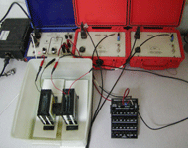


|
Home Equipment Services | Field Surveys | Applications | Consulting | Lab Properties | | ComplexResistivity | | IP, Resistivity | | Conductivity | | Susceptibility | | Magnetization | | Density, Porosity | Ore Minerals Software About Us Contact News |
|
3322 E Fort Lowell Rd |

Physical Property Laboratory Measurements
The Zonge International Tucson office has a well-equipped laboratory for routine determinations of magnetic, electrical, and density physical properties. Laboratory equipment for sample preparation include diamond saws and core drill, including non-magnetic types for natural remanent magnetization studies. Vacuum impregnation equipment is available for moisture saturating samples for specific determinations.
Rock Physical Property Data is useful for:
- Geophysical survey planning
- Geophysical feasibility studies
- Anomaly drill test confirmation
- Refine data interpretation
- Aid geological/geophysical correlation
Sample Selection
Samples for physical property measurements should be judiciously selected in terms of quantity and typical characteristics for meaningful results. The physical property measurements are no better than the degree that the samples represent the formation or mineralized zone under study. A suite of samples from within the area under investigation, or from available core from a drillhole should be selected. To determine anisotropic physical properties such as commonly occurs in bedded or schistose rocks, it is strongly recommended that samples be cubed or cored in three mutually orthogonal directions in order to completely define physical property anisotropy. This would consist of three tests instead of one test per sample.
In general, samples should be selected with a minimum size of 4" by 4" by 4" (10cm by 10cm by 10cm) (large fist size) for bulk samples, or 5" (13cm) of core and for most procedures the samples should be fracture-free. Mended / silicified fractures are usually strong enough to withstand the cutting process. If this size is not attainable, two or three pieces of a slightly smaller size should suffice. It is best to send an excess of samples in either size or quantity so that the laboratory staff can select suitable samples for physical property determinations. Depending upon the physical property procedures desired, samples can be surface or underground grab samples, drill core of any diameter, chip samples or mud samples.
Chip / Clay / Sand Requirements
- Minimum volume of 1.85 in3 (30 cm3)
- 1.06 ounces (30 g) for clay / sand
- 1.41 ounces (40 g) chip samples
Sample Handling
In the laboratory, physical property determinations are generally non-destructive procedures except for coring or sawing of the core samples which may be necessary for preparation. The normal sample preparation is to cross-core a one inch core cut from the submitted sample to form a bicylindrical or double cored one inch sample. This sample size and shape is necessary for magnetic remanence and susceptibility measurements and can be utilized also for electrical and density determinations. Samples are handled carefully during physical property studies. All samples, cores and cut off remnants will be returned to the client, and may be subsequently analyzed chemically or petrographically for correlation purposes.
Sample Documentation
All samples submitted to the laboratory should be carefully marked, preferably with waterproof ink, and bagged or otherwise wrapped with sample identification clearly indicated. Samples for which magnetic remanence vector measurements are requested should be oriented in space. All samples should be accompanied by a letter describing the samples, sample designations, requested property procedures, appropriate parameters such as IP time cycle, orientation, etc. and final disposition of the samples.
Sample Orientation
Measurements of the magnetic remanence vector require that the in situ orientation in space for the sample be documented.
Core Samples
Most holes are drilled at an angle, not vertical. Orient the sample as it was in situ, with the appropriate end pointed towards the surface, and rotated so the appropriate cylindrical "side" is oriented "up". Mark an arrow on the "top" of the cylindrical side, pointed downhole. Document the declination and inclination for this arrow.
Other Samples
All other samples should be marked with three lines. On the top surface, mark an arrow pointing North. On each of two (preferably perpendicular) sides mark a line indicating horizontal.
Laboratory Measurements Pricing
The costs of physical property procedures depends on the specific procedures required, the type of sample submitted and the necessary sample preparation. Firm physical property procedures quotes can quickly be obtained by telephone, Email or letter as required. Quoted prices will include sample preparation, physical property determination(s) and laboratory reporting. Incidental expenses and shipping costs will be the responsibility of the client. Requests for expedited processing may be accommodated if arrangements are made prior to receipt of samples.

